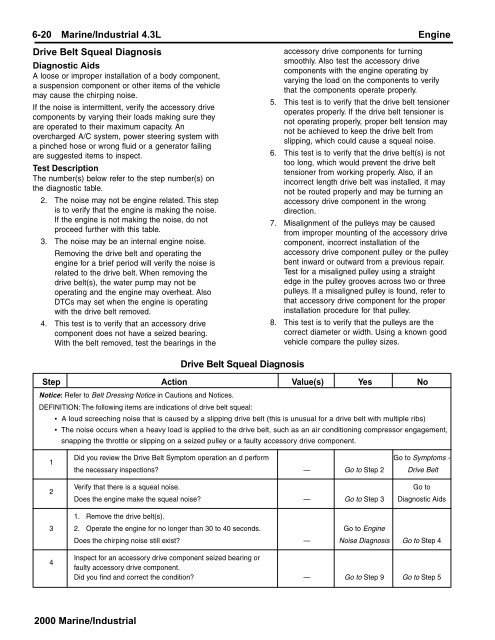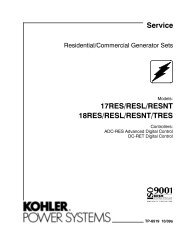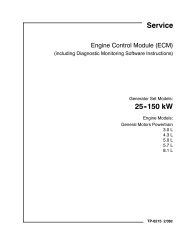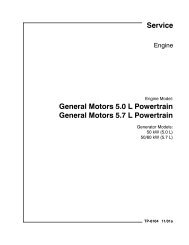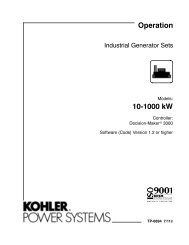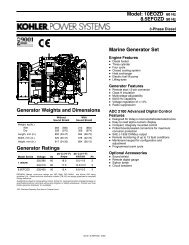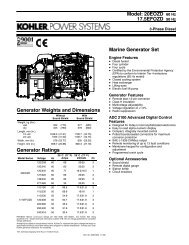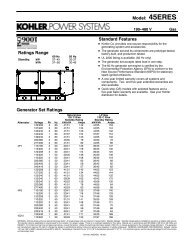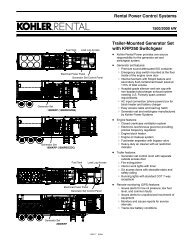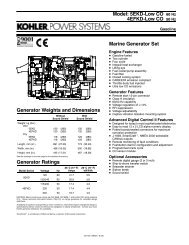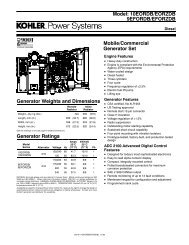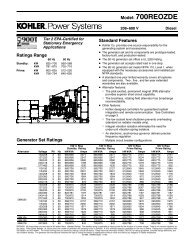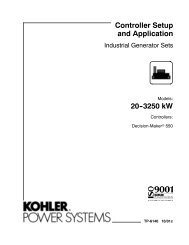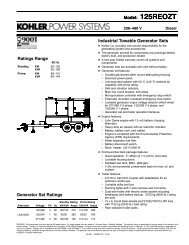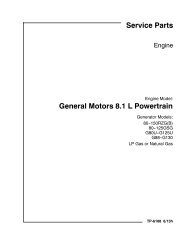Service Manual, General Motors 4.3L Engine (TP ... - Kohler Power
Service Manual, General Motors 4.3L Engine (TP ... - Kohler Power
Service Manual, General Motors 4.3L Engine (TP ... - Kohler Power
Create successful ePaper yourself
Turn your PDF publications into a flip-book with our unique Google optimized e-Paper software.
6-20 Marine/Industrial <strong>4.3L</strong> <strong>Engine</strong><br />
Drive Belt Squeal Diagnosis<br />
Diagnostic Aids<br />
A loose or improper installation of a body component,<br />
a suspension component or other items of the vehicle<br />
may cause the chirping noise.<br />
If the noise is intermittent, verify the accessory drive<br />
components by varying their loads making sure they<br />
are operated to their maximum capacity. An<br />
overcharged A/C system, power steering system with<br />
a pinched hose or wrong fluid or a generator failing<br />
are suggested items to inspect.<br />
Test Description<br />
The number(s) below refer to the step number(s) on<br />
the diagnostic table.<br />
2. The noise may not be engine related. This step<br />
is to verify that the engine is making the noise.<br />
If the engine is not making the noise, do not<br />
proceed further with this table.<br />
3. The noise may be an internal engine noise.<br />
Removing the drive belt and operating the<br />
engine for a brief period will verify the noise is<br />
related to the drive belt. When removing the<br />
drive belt(s), the water pump may not be<br />
operating and the engine may overheat. Also<br />
DTCs may set when the engine is operating<br />
with the drive belt removed.<br />
4. This test is to verify that an accessory drive<br />
component does not have a seized bearing.<br />
With the belt removed, test the bearings in the<br />
accessory drive components for turning<br />
smoothly. Also test the accessory drive<br />
components with the engine operating by<br />
varying the load on the components to verify<br />
that the components operate properly.<br />
5. This test is to verify that the drive belt tensioner<br />
operates properly. If the drive belt tensioner is<br />
not operating properly, proper belt tension may<br />
not be achieved to keep the drive belt from<br />
slipping, which could cause a squeal noise.<br />
6. This test is to verify that the drive belt(s) is not<br />
too long, which would prevent the drive belt<br />
tensioner from working properly. Also, if an<br />
incorrect length drive belt was installed, it may<br />
not be routed properly and may be turning an<br />
accessory drive component in the wrong<br />
direction.<br />
7. Misalignment of the pulleys may be caused<br />
from improper mounting of the accessory drive<br />
component, incorrect installation of the<br />
accessory drive component pulley or the pulley<br />
bent inward or outward from a previous repair.<br />
Test for a misaligned pulley using a straight<br />
edge in the pulley grooves across two or three<br />
pulleys. If a misaligned pulley is found, refer to<br />
that accessory drive component for the proper<br />
installation procedure for that pulley.<br />
8. This test is to verify that the pulleys are the<br />
correct diameter or width. Using a known good<br />
vehicle compare the pulley sizes.<br />
Drive Belt Squeal Diagnosis<br />
Step Action Value(s) Yes No<br />
Notice: Refer to Belt Dressing Notice in Cautions and Notices.<br />
DEFINITION: The following items are indications of drive belt squeal:<br />
• A loud screeching noise that is caused by a slipping drive belt (this is unusual for a drive belt with multiple ribs)<br />
• The noise occurs when a heavy load is applied to the drive belt, such as an air conditioning compressor engagement,<br />
snapping the throttle or slipping on a seized pulley or a faulty accessory drive component.<br />
1<br />
2<br />
Did you review the Drive Belt Symptom operation an d perform Go to Symptoms -<br />
the necessary inspections? — Go to Step 2 Drive Belt<br />
Verify that there is a squeal noise.<br />
Go to<br />
Does the engine make the squeal noise? — Go to Step 3 Diagnostic Aids<br />
1. Remove the drive belt(s).<br />
3 2. Operate the engine for no longer than 30 to 40 seconds. Go to <strong>Engine</strong><br />
Does the chirping noise still exist? — Noise Diagnosis Go to Step 4<br />
4<br />
Inspect for an accessory drive component seized bearing or<br />
faulty accessory drive component.<br />
Did you find and correct the condition? — Go to Step 9 Go to Step 5<br />
2000 Marine/Industrial


